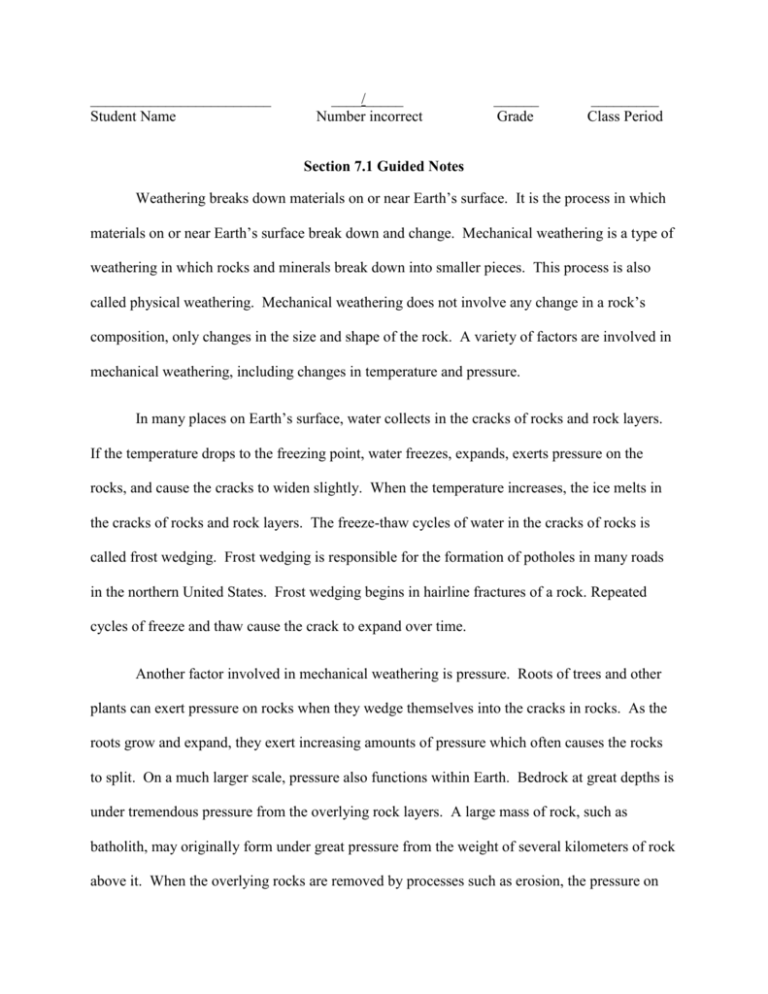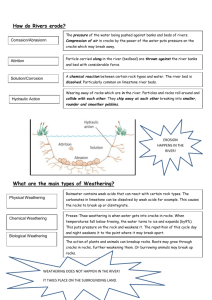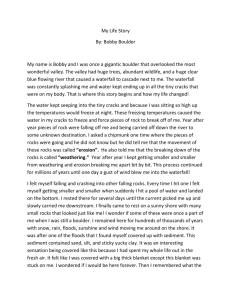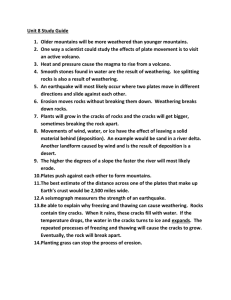____/_____ ______ ______ Student Name Number incorrect Grade
advertisement

________________________ Student Name ____/_____ Number incorrect ______ Grade _________ Class Period Section 7.1 Guided Notes Weathering breaks down materials on or near Earth’s surface. It is the process in which materials on or near Earth’s surface break down and change. Mechanical weathering is a type of weathering in which rocks and minerals break down into smaller pieces. This process is also called physical weathering. Mechanical weathering does not involve any change in a rock’s composition, only changes in the size and shape of the rock. A variety of factors are involved in mechanical weathering, including changes in temperature and pressure. In many places on Earth’s surface, water collects in the cracks of rocks and rock layers. If the temperature drops to the freezing point, water freezes, expands, exerts pressure on the rocks, and cause the cracks to widen slightly. When the temperature increases, the ice melts in the cracks of rocks and rock layers. The freeze-thaw cycles of water in the cracks of rocks is called frost wedging. Frost wedging is responsible for the formation of potholes in many roads in the northern United States. Frost wedging begins in hairline fractures of a rock. Repeated cycles of freeze and thaw cause the crack to expand over time. Another factor involved in mechanical weathering is pressure. Roots of trees and other plants can exert pressure on rocks when they wedge themselves into the cracks in rocks. As the roots grow and expand, they exert increasing amounts of pressure which often causes the rocks to split. On a much larger scale, pressure also functions within Earth. Bedrock at great depths is under tremendous pressure from the overlying rock layers. A large mass of rock, such as batholith, may originally form under great pressure from the weight of several kilometers of rock above it. When the overlying rocks are removed by processes such as erosion, the pressure on the bedrock is reduced. The bedrock surface that was buried expands, and long, curved, cracks can form. These cracks, also known as joints, occur parallel to the surface of the rocks. Reduction of pressure allows existing cracks in the bedrock to widen. Over time, the outer layers of rock can be stripped away in succession. The process by which outer rock layers are stripped away is called exfoliation. Exfoliation often results in dome-shaped formations. The rock that makes up Half Dome in Yosemite National Park fractures along its outer surface in this process of exfoliation. Chemical weathering is the process by which rocks and minerals undergo changes in their composition. Agents of chemical weathering include water, oxygen, carbon dioxide, and acid precipitation. The interaction of these agents with rock can cause some substances to dissolve, and some new minerals to form. The new minerals have properties different than those that were in the original rock. The composition of a rock determines the effects that chemical weathering will have on it. Temperature is another significant factor in chemical weathering because it influences the rate at which chemical interactions occur. Chemical reaction rates increase as temperature increases. With all other factors being equal, the rate of chemical weathering reactions doubles with each 10 degree Celsius increase in temperature. Water is an important agent in chemical weathering because it can dissolve many kinds of minerals and rocks. Water also plays an active role in many reactions by serving as a medium in which the reactions can occur. Water can also react directly with minerals in a chemical reaction. An important element in chemical weathering is oxygen. The chemical reaction of oxygen with other substances is called oxidation. Approximately 21% of Earth’s atmosphere is oxygen gas. Iron in rocks and minerals combines with this atmospheric oxygen to form minerals with the oxidized form of iron. Another atmospheric gas that contributes to the chemical weathering process is carbon dioxide. Carbon dioxide is a gas that occurs naturally in the atmosphere as a product of living organisms. When carbon dioxide combines with water in the atmosphere, it forms a very weak acid called carbonic acid that falls to Earth’s surface as precipitation. Precipitation includes rain, snow, sleet, and fog. Natural precipitation has a pH of 5.6. The slight acidity of precipitation causes it to dissolve certain rocks. Decaying organic matter and respiration produce high levels of carbon dioxide. When slightly acidic water from precipitation seeps into the ground and combines with carbon dioxide in the soil, carbonic acid becomes an agent in the chemical weathering process. Another agent of chemical weathering is acid precipitation, which is caused by sulfur dioxide, carbon dioxide, and nitrogen oxides. These compounds are released into the atmosphere, often by human activities. Sulfur dioxide and carbon dioxide are primarily the product of burning fossil fuels. Motor vehicle exhaust contributes to the emissions of nitrogen oxides. These three gases combine with oxygen and water in the atmosphere and form strong sulfuric, nitric, and carbonic acids. Because strong acids can be harmful to many organisms and destructive to human-made structures, acid precipitation often creates problems. Many plant and animal populations cannot survive even slight changes in acidity. Acid precipitation can make forests more vulnerable to disease and damage by insects. The impact of chemical weathering is related to a region’s climate. Precipitation, temperature, and evaporation are factors of climate. The interaction between temperature and precipitation in a given climate determines the rate of weathering in a region. Chemical weathering is rapid in climates with warm temperatures, abundant rainfall, and lush vegetation. These climatic conditions produce soils that are rich in organic matter. Water from heavy rainfalls combines with the carbon dioxide in soil organic matter and produces high levels of carbonic acid. The resulting carbonic acid accelerates the weathering process. Chemical weathering has the greatest effects along the equator, where rainfall is plentiful and the temperature tends to be high. Physical weathering can break down rocks more rapidly in cool climates. Physical weathering rates are highest in areas where water in cracks within the rocks undergoes repeated freezing and thawing. Conditions in such climates do not favor chemical weathering because cool temperatures slow or inhibit chemical reactions. Little or no chemical weathering occurs in areas that are frigid year-round. Not all the rocks in the same climate weather at the same rate. The effects of climate on the weathering of rock also depends on the rock type and composition. The rate of weathering also depends on the surface area that is exposed. Mechanical weathering breaks rocks into smaller pieces. As the pieces get smaller, their surface area increases. When this happens there is more total surface area available for chemical weathering. The result is that weathering has more of an effect on smaller particles. The slope of a landscape also determines the rate of weathering. Rocks on level areas are likely to remain in place over time, whereas the same rocks on slopes tend to move as a result of gravity. Steep slopes therefore promote erosion and continually expose less-weathered material. ________________________ Student Name ____/_____ Number incorrect ______ Grade _________ Class Period Section 7.1 Guided Notes ________________ breaks down materials on or near Earth’s surface. It is the process in which materials on or near Earth’s surface __________ down and _________. Mechanical weathering is a type of weathering in which ___________ and ______________ break down into smaller pieces. This process is also called ______________ _______________. Mechanical weathering does not involve any change in a rock’s __________________, only changes in the _________ and ____________ of the rock. A variety of factors are involved in mechanical weathering, including changes in ____________________ and ____________________. In many places on Earth’s surface, water collects in the ___________ of rocks and rock layers. If the temperature ____________ to the freezing point, water _______________, ________________, exerts __________________ on the rocks, and cause the cracks to _______________ slightly. When the temperature ____________________, the ice ___________ in the cracks of rocks and rock layers. The ___________________ cycles of water in the cracks of rocks is called _________________ _________________. Frost wedging is responsible for the formation of __________________ in many roads in the northern United States. Frost wedging begins in _______________ ____________________ of a rock. Repeated cycles of freeze and thaw cause the crack to _______________ over time. Another factor involved in mechanical weathering is _________________. ___________ of trees and other plants can exert pressure on rocks when they wedge themselves into the cracks in rocks. As the roots ____________ and ______________, they exert increasing amounts of pressure which often causes the rocks to split. On a much larger scale, pressure also functions within __________________. Bedrock at great depths is under tremendous pressure from the __________________ _______________ __________________. A large mass of rock, such as ________________, may originally form under great pressure from the weight of several kilometers of rock above it. When the overlying rocks are removed by processes such as ________________, the pressure on the bedrock is _______________. The bedrock surface that was buried ____________, and long, curved, cracks can form. These cracks, also known as _________________, occur __________________ to the surface of the rocks. _____________ of pressure allows existing cracks in the bedrock to _______________. Over time, the outer layers of rock can be stripped away in ___________________. The process by which outer rock layers are stripped away is called ______________________. Exfoliation often results in ___________________________ formations. The rock that makes up Half Dome in __________________ _______________________ ______________ fractures along its outer surface in this process of exfoliation. __________________________ weathering is the process by which rocks and minerals undergo changes in their __________________. Agents of chemical weathering include _________________, _________________, __________________________, and _________________________________. The interaction of these agents with rock can cause some substances to ______________________, and some new minerals to ______________. The new minerals have properties ______________________ than those that were in the original rock. The ________________________ of a _______________ determines the effects that chemical weathering will have on it. _________________________ is another significant factor in chemical weathering because it influences the rate at which ___________________ ___________________ occur. Chemical reaction rates _________________ as temperature __________________________. With all other factors being equal, the rate of chemical weathering reactions _________________ with each 10 degree Celsius ________________ in temperature. _________________ is an important agent in chemical weathering because it can dissolve many kinds of minerals and rocks. Water also plays an ______________ role in many reactions by serving as a __________________ in which the reactions can occur. Water can also ______________ directly with minerals in a chemical reaction. An important element in chemical weathering is ________________. The chemical reaction of oxygen with other substances is called ___________________. Approximately _____% of Earth’s atmosphere is _____________ _________. Iron in rocks and minerals combines with this _________________ oxygen to form minerals with the oxidized form of iron. Another atmospheric gas that contributes to the _______________ weathering process is ________________ __________________. Carbon dioxide is a _________ that occurs _____________________ in the atmosphere as a product of living organisms. When carbon dioxide combines with _____________ in the atmosphere, it forms a very weak acid called _____________________ ______________ that falls to Earth’s surface as ___________________. Precipitation includes ____________, _____________, ___________, and _______. Natural precipitation has a pH of _________. The slight _________________ of precipitation causes it to _____________ certain rocks. Decaying ________________ matter and ___________________ produce high levels of carbon dioxide. When slightly acidic water from precipitation _____________ into the ground and ________________ with carbon dioxide in the soil, _________________ _____________ becomes an agent in the chemical weathering process. Another agent of chemical weathering is ___________ _______________________, which is caused by _____________ ______________, _____________ _________________, and ________________ ___________. These compounds are released into the atmosphere, often by ______________ activities. Sulfur dioxide and carbon dioxide are primarily the product of __________________ _______________ _________________. Motor vehicle exhaust contributes to the ____________________ of nitrogen oxides. These ___________ gases combine with _________________ and ________________ in the atmosphere and form strong ________________, nitric, and ________________ acids. Because strong acids can be __________________ to many organisms and destructive to human-made structures, __________ ___________________________ often creates problems. Many plant and animal populations cannot survive even slight changes in _______________. Acid precipitation can make _________________ more vulnerable to ________________ and ______________ by insects. The impact of chemical weathering is related to a _________________ _________________. Precipitation, __________________, and _______________ are factors of climate. The _________________ between temperature and precipitation in a given climate determines the ____________ of ___________________ in a region. Chemical weathering is __________________ in climates with warm ________________, abundant _________________, and lush ______________. These climatic conditions produce ___________ that are rich in organic matter. _______________ from heavy rainfalls combines with the _______________ _________________ in soil organic matter and produces __________ levels of carbonic acid. The resulting carbonic acid ______________________ the weathering process. __________________ weathering has the ________________ effects along the equator, where _________________ is plentiful and the ________________________ tends to be high. _____________________ weathering can break down rocks _________________ rapidly in ______________ climates. Physical weathering rates are ___________________ in areas where water in cracks within the rocks undergoes repeated _________________ and ___________________. Conditions in such climates do not favor __________________ weathering because __________________ temperatures ___________ or ______________ chemical reactions. Little or no __________________ weathering occurs in areas that are frigid year-round. Not all the rocks in the same __________________ weather at the same ____________. The effects of climate on the weathering of rock also depends on the rock ____________ and ____________________. The rate of weathering also depends on the ____________ area that is _______________. Mechanical weathering breaks rocks into ____________ pieces. As the pieces get smaller, their surface area _________________. When this happens there is _________ total surface area available for chemical weathering. The result is that weathering has ____________ of an effect on _____________ particles. The ____________ of a landscape also determines the ______________ of weathering. Rocks on ____________ areas are likely to remain in place over time, whereas the same rocks on slopes tend to _____________ as a result of _______________. Steep slopes therefore promote ________________ and continually _______________ less-weathered material. Mechanical Weathering Chemical Weathering








